10 Essential Tips When Growing Raspberries In Pots (With Recommended Dwarf Cultivars)

FRUIT > RASPBERRY > CONTAINERS

Elizabeth is a Permaculture Garden Designer, Sustainability Consultant and Professional Writer, working as an advocate for positive change. She graduated from the University of St. Andrews with an MA in English and Philosophy and obtained a Diploma in Applied Permaculture Design from the Permaculture Association.
Reviewed By COLIN SKELLY

Colin is a Horticulturist and Horticultural Consultant with experience in a range of practical and managerial roles across heritage, commercial and public horticulture. He holds the Royal Horticultural Society’s Master of Horticulture award and has a particular interest in horticultural ecology and naturalistic planting for habitat and climate resilience.
IN THIS GUIDE
- Can You Grow Raspberries In Pots?
- 1) Choose Dwarf Cultivars
- 2) The Larger The Pot The Better
- 3) John Innes No. 3 Works Well
- 4) Avoid Overcrowding Plants
- 5) Avoid Pot-Sharing (If Possible!)
- 6) Add Support For Taller Raspberry Varieties
- 7) Container Raspberries Need Extra Watering
- 8) Feed Well For A Higher Yield
- 9) Watch Closely For Pests
- 10) Prune According To Type
RASPBERRY GUIDES
Containers
Pruning
Raspberries are one of the most delicious fruits that can be grown at home.
They are easy to grow and provide a wealth of berries even in the smallest of gardens.
If you only have limited space available, you might be wondering whether you can grow raspberries in a container.
Can You Grow Raspberries In Pots?
Raspberries are cane fruits that will always do best when planted in the ground where possible.
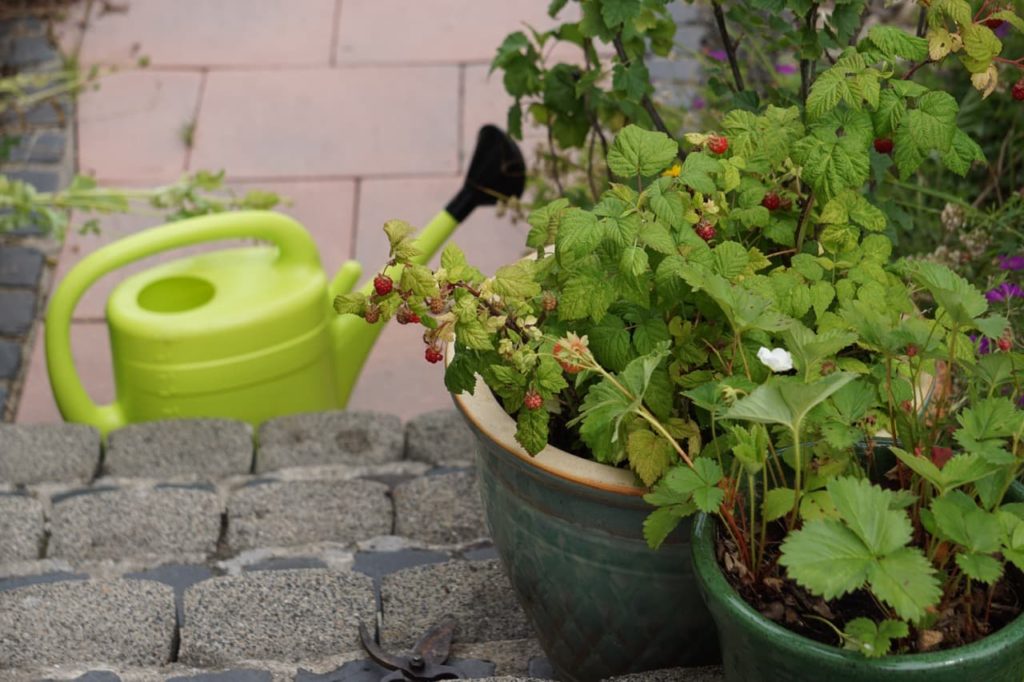
However, as long as they are positioned and cared for correctly, it is certainly possible to grow raspberries in pots.
I just find that they grow less rigorously and offer less of a yield than you might expect from plants grown in the ground.
But I certainly wouldn’t let that stop you from container growing. Here are my top tips for growing plentiful raspberries in pots:
1) Choose Dwarf Cultivars
First things first, you’ll need to choose a suitable variety.
Some will grow taller and be more vigorous than others, whilst some raspberry varieties will be better suited to container cultivation.
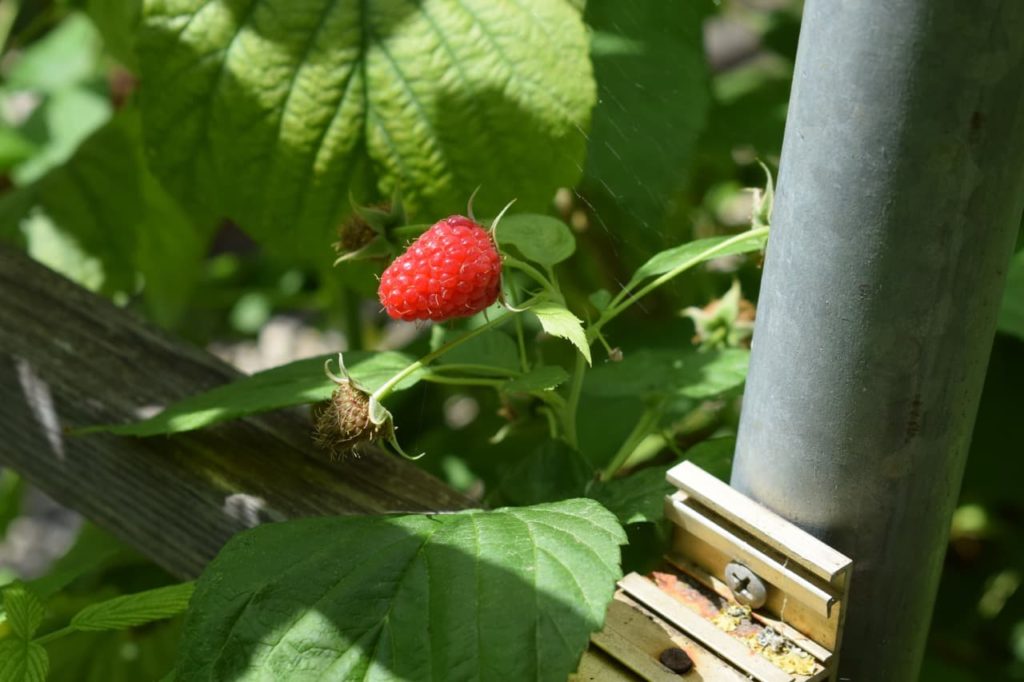
Dwarf raspberry varieties for patio growing in containers are now available, so when you are restricted to container gardening, these are definitely the best choice.
The best known (and first in the UK) was the ‘Ruby Beauty’ cultivar launched by Thompson & Morgan, but several other cultivars are now also available.
Raspberry ‘Yummy’ and Lowberry® would make equally good choices.
2) The Larger The Pot The Better
Once you have chosen which raspberries to grow in pots, you will need to spend a little time choosing a container of some kind.
How large your container should be will depend on how many raspberry canes you wish to grow in it but, generally, the larger the better.
Raspberries, even compact dwarf varieties, are relatively large plants that require a sizeable and sturdy pot for stability.
Any pot, even for a single raspberry cane, will need to be an absolute minimum of 30cm across.
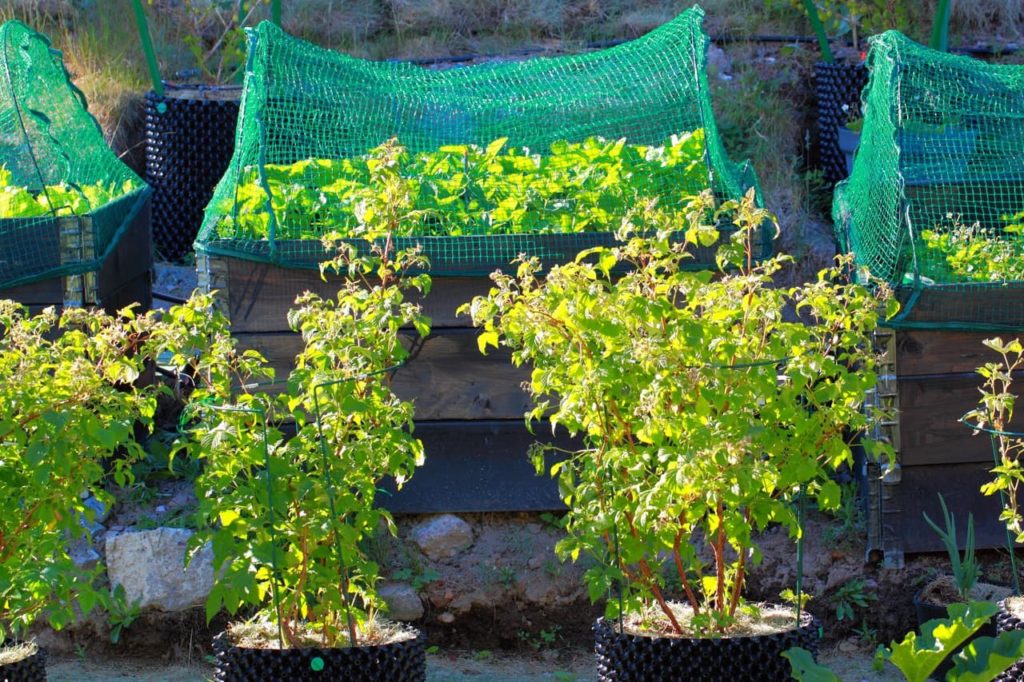
A strong terracotta or ceramic pot will be ideal but you might also consider a range of reclaimed or repurposed options.
Remember that whatever container you choose should allow water to drain away freely through holes at the base.
3) John Innes No. 3 Works Well
The best option for growing raspberries in a container is a potting mix with loam or soil, which will have the nutrients and moisture required to keep your raspberry plants happy and healthy.
A slightly acidic mix is ideal.
If you are purchasing a potting mix then choose one that is peat-free, such as John Innes No. 3 or an equivalent formulation.
Alternatively, make your own mix with 1/3 loam soil, 1/3 homemade compost and 1/3 leaf mould.
4) Avoid Overcrowding Plants
You can purchase raspberries as container plants but it is most common to purchase the canes bare-root during the autumn or winter months.
When potting up raspberries, you will have to decide how many to place in your chosen container.

It is important to make sure that the raspberry plants are not overcrowded or placed too close to one another.
Whether or not you can place more than one raspberry cane in a pot will depend on the size of the container that you have chosen.
Make sure that raspberries are planted to the same depth in the growing medium that they were at in their previous location.
5) Avoid Pot-Sharing (If Possible!)
You can place a single raspberry plant in a pot that is a minimum of 30cm wide.
In a pot that is 55-60cm in diameter, I’d argue there’s room for roughly three raspberry canes in the same container.
However, since raspberries have fairly shallow roots, it is not usually a good idea to place them into a container that they share with other plants.

That being said, there are plants that will benefit raspberries and these can be usefully grown in pots nearby, just as they can when grown nearby in the soil in a garden.
Rue, tansy, lavender and onion family plants are just a few examples of companion plants that could be beneficial.
6) Add Support For Taller Raspberry Varieties
Taking care of raspberries in containers will take a little more work and effort than growing them in the ground.
However, you should still find it a relatively easy and straightforward process.
Many raspberries will stand up on their own, especially the smaller dwarf cultivars that are ideal for growing in containers.
However, if you are growing a taller cultivar, you may need to support your plants.
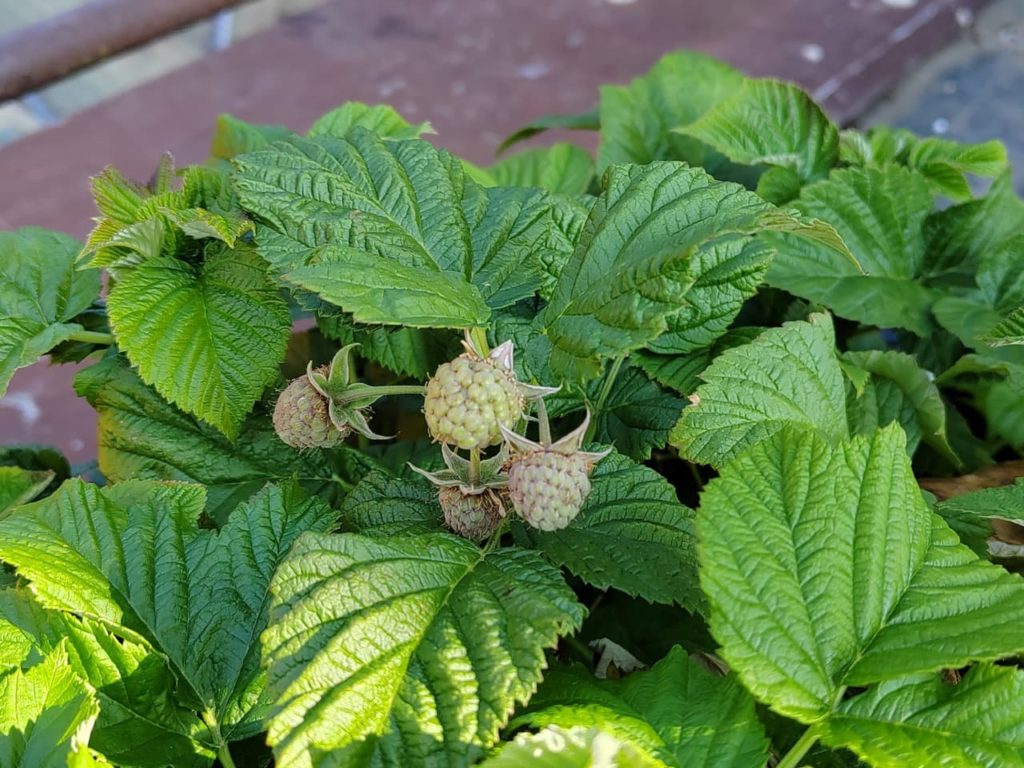
A simple solution for support for raspberries in pots involves placing three bamboo canes in a pot, tied together at the top, with natural twine between them.
If you are not growing your raspberries in a fruit cage, this structure can also be netted where necessary so that you can harvest your raspberries before they are all eaten by birds or other wildlife.
7) Container Raspberries Need Extra Watering
Water consistently throughout the growing season.
Remember that raspberries in pots will typically need to be watered more often than those growing in the ground because pots will dry out more quickly.
“For successful cropping in a pot, watering will need to be very frequent in the summer months,” says Colin Skelly, a Master Horticulturist.
“Ideally, a drip system of irrigation, either hose-fed or from a sump system (such as an upside-down bottle with drip nozzle attached and filled regularly), would be in place to ensure that water is always available for uptake by roots.”
Directly water at the base of the canes where it is needed and make sure excess water can drain away freely.
8) Feed Well For A Higher Yield
Top-dressing your containers with homemade compost, well-rotted manure or other organic matter is a good idea.
This will not only help to retain moisture, but it will also provide slow-release fertility for your raspberry plants.
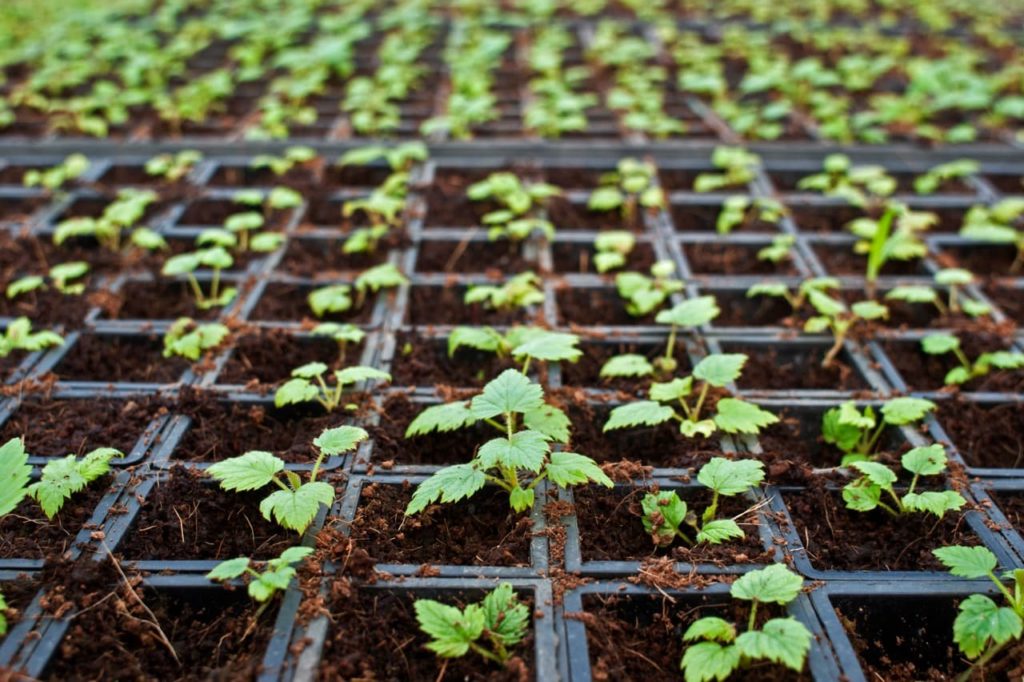
You can also consider feeding raspberries while they flower and fruit with a potassium-rich liquid plant feed (such as comfrey tea) to promote healthy flowering and fruit production.
Yellowing leaves can sometimes be a sign of nitrogen deficiency, so if you see this, feeding with a nitrogen-rich organic feed (like a nettle feed) could be beneficial.
9) Watch Closely For Pests
Raspberries can, unfortunately, fall prey to a number of pests and diseases.
Pests include raspberry beetles, red spider mites, raspberry bud mites and red berry mites, as well as birds and mammals that can eat the berries before you get a share.
Companion planting, creating rich biodiversity in your garden as a whole and using physical barriers where necessary are the best strategies to combat any pest issues.
Diseases may also sometimes take hold.
Look out for issues like grey moulds, fungal leaf spots, raspberry cane spots and raspberry cane blight and remove infected leaves as soon as you spot them.
10) Prune According To Type
Pruning raspberries can seem like a complex business and how precisely you will prune will depend on which varieties you are growing.
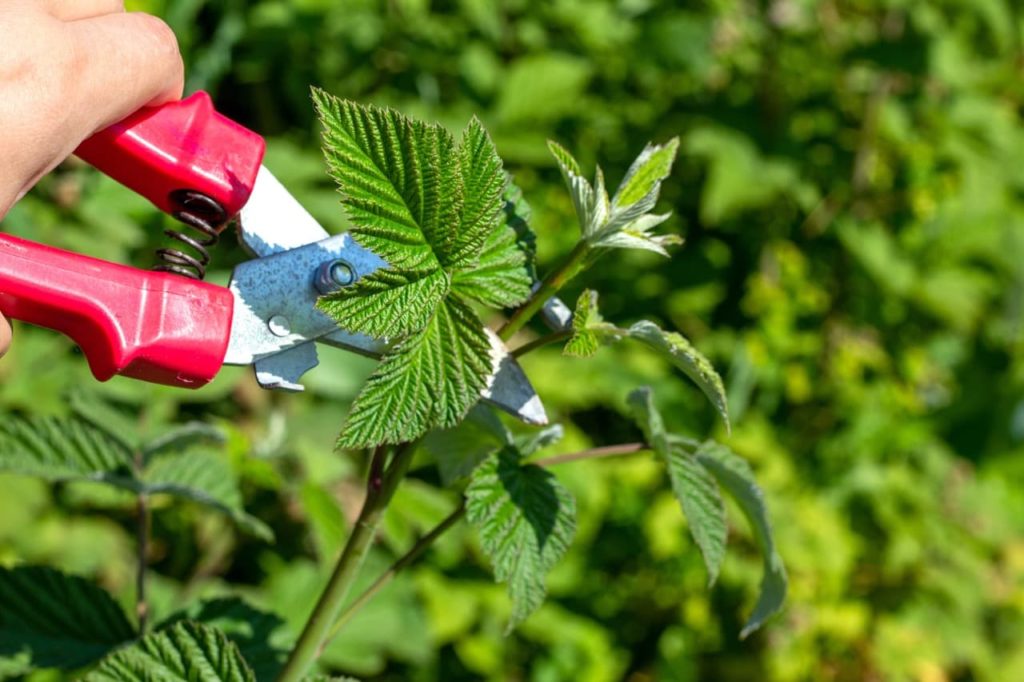
‘Ruby Beauty’ has canes pruned back to the base after fruiting and the same is true for all raspberries that fruit on the primocanes (present year’s growth).
However, care is needed because there are also summer raspberries that fruit on floricanes (second year’s growth) and with these it is, of course, important not to prune back the canes that will fruit the following year.
Growing raspberries in pots will involve more care, particularly when it comes to watering.
However, raspberries growing in pots can be the perfect addition to a small yet perfectly formed food-producing garden.
